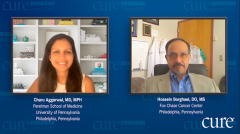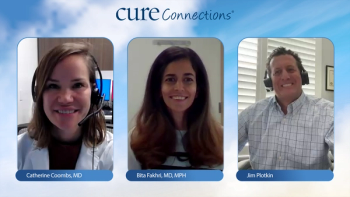
Addressing Barriers to Molecular Testing in NSCLC
Reactions to low rates of molecular testing for patients with non-small cell lung cancer in community settings.
Episodes in this series

Charu Aggarwal, M.D., MPH: Recent data show that there are many challenges. We saw presentations at this year’s American Society of Clinical Oncology annual meeting where rates of molecular testing are pretty dismal: only 50%. Even though you and I in our clinics are striving for 100% testing, in reality, in our practices—including not just university sites but also community practices—rates of testing are only in the order of 20%. Can you comment on why this is the case, what challenges there might be, and how we could potentially fix them?”
Hossein Borghaei, DO, MS: I’ll try to shed some light on that. I’m not going to claim that I have all of the answers, because I don’t think any of the experts we have talked to know all of the answers. But it’s absolutely unacceptable that we have such a low molecular testing rate all over the country. You’re right; it’s not only geographic, but also where the patient is being treated.
The challenges are multiple, depending on wherever you practice. For instance, if you live closer to an academic center or you’re being seen at a cancer center like yours or ours, access to molecular testing is pretty routine because we do in-house testing. Even if we don’t do in-house testing, we work with facilities that are in the business of doing the molecular testing.
In some parts of the country, that seems to be a bit more of a difficult issue because for tumor-based analysis, you need adequate tissue. The biopsy you do at the time of initial diagnosis has to have enough cancer cells in it for not only the pathologist to make an accurate diagnosis of what’s going on, but with enough leftover material for someone to do the extraction of the DNA and the elaborate DNA sequencing for genetic analysis.
On top of that, we’ve now added this component of looking for particular fusions that could possibly be missed with a simple DNA analysis. That adds another level of complexity. Sometimes it’s hard to obtain enough tumor sample at the time of initial biopsy to do all of these tests. Challenge No. 1 is accessibility of tissue or not being able to get adequate samples. That by itself can be subdivided into multiple issues: a lack of expertise in obtaining additional samples, or difficult to reach areas where you can’t put a patient at risk, leading to a smaller biopsy.
I fully admit that I’m a bit of a late comer to the concept of liquid biopsy panels. You’ve been involved in this for much longer, and [have contributed to] a lot more publications in this area. But I would have thought that the idea of having availability of a liquid panel—such that a clinician can draw two tubes of blood at the time of visit and send it off for a panel testing that includes most of what we need to have at the time of diagnosis—would have equalized the matter a little more. Perhaps dissemination of the information of the liquid panels can be helpful in this area and would be another way of overcoming some of the challenges we’re facing with molecular testing.
But there’s concern on the part of the patient regarding financial issues with some of these tests. They’re important, but this testing is unfortunately somewhat expensive. Coming up with solutions to any potential financial barriers is important. Whether that’s real or assumed is a different discussion, but there are multiple challenges that we have to overcome. As clinicians, the decision here is, as you pointed out, what’s the best thing for the patient? If that’s the way we enter this, then the best thing for the patient becomes obvious: it’s to do the molecular testing, whether it’s liquid, tumor, or preferably both. That has to be solved within the individual practices that are seeing patients.
I firmly believe this is an area where patients can be their own best advocates. Patients should visit a lot of the patient advocacy websites, meetings, and talks, and learn about the importance of molecular testing so they can advocate for themselves when they see their oncologist and ask, “What are my molecular results? Do I have an alteration?” Empowering patients can also help overcome some of these barriers to some extent, and I’m hoping that the additional information, education, and everything else that we’ve all been doing will help us get there.
Transcript edited for clarity.


